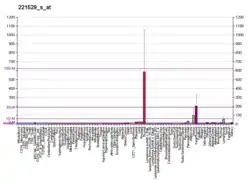| PLVAP | |||||||||||||||||||||||||||||||||||||||||||||||||||
|---|---|---|---|---|---|---|---|---|---|---|---|---|---|---|---|---|---|---|---|---|---|---|---|---|---|---|---|---|---|---|---|---|---|---|---|---|---|---|---|---|---|---|---|---|---|---|---|---|---|---|---|
| Identifiers | |||||||||||||||||||||||||||||||||||||||||||||||||||
| Aliases | PLVAP, FELS, PV-1, PV1, gp68, plasmalemma vesicle associated protein, DIAR10 | ||||||||||||||||||||||||||||||||||||||||||||||||||
| External IDs | OMIM: 607647 MGI: 1890497 HomoloGene: 10578 GeneCards: PLVAP | ||||||||||||||||||||||||||||||||||||||||||||||||||
| |||||||||||||||||||||||||||||||||||||||||||||||||||
| |||||||||||||||||||||||||||||||||||||||||||||||||||
| |||||||||||||||||||||||||||||||||||||||||||||||||||
| |||||||||||||||||||||||||||||||||||||||||||||||||||
| |||||||||||||||||||||||||||||||||||||||||||||||||||
| Wikidata | |||||||||||||||||||||||||||||||||||||||||||||||||||
| |||||||||||||||||||||||||||||||||||||||||||||||||||
Plasmalemma vesicle-associated protein is a protein that in humans is encoded by the PLVAP gene.[5][6]
References
- 1 2 3 GRCh38: Ensembl release 89: ENSG00000130300 - Ensembl, May 2017
- 1 2 3 GRCm38: Ensembl release 89: ENSMUSG00000034845 - Ensembl, May 2017
- ↑ "Human PubMed Reference:". National Center for Biotechnology Information, U.S. National Library of Medicine.
- ↑ "Mouse PubMed Reference:". National Center for Biotechnology Information, U.S. National Library of Medicine.
- ↑ Stan RV, Arden KC, Palade GE (Jun 2001). "cDNA and protein sequence, genomic organization, and analysis of cis regulatory elements of mouse and human PLVAP genes". Genomics. 72 (3): 304–13. doi:10.1006/geno.2000.6489. PMID 11401446.
- ↑ "Entrez Gene: PLVAP plasmalemma vesicle associated protein".
Further reading
- Stan RV, Ghitescu L, Jacobson BS, Palade GE (1999). "Isolation, Cloning, and Localization of Rat PV-1, a Novel Endothelial Caveolar Protein". J. Cell Biol. 145 (6): 1189–98. doi:10.1083/jcb.145.6.1189. PMC 2133139. PMID 10366592.
- Hnasko R, McFarland M, Ben-Jonathan N (2003). "Distribution and characterization of plasmalemma vesicle protein-1 in rat endocrine glands". J. Endocrinol. 175 (3): 649–61. CiteSeerX 10.1.1.322.5434. doi:10.1677/joe.0.1750649. PMID 12475376.
- Strausberg RL, Feingold EA, Grouse LH, et al. (2003). "Generation and initial analysis of more than 15,000 full-length human and mouse cDNA sequences". Proc. Natl. Acad. Sci. U.S.A. 99 (26): 16899–903. Bibcode:2002PNAS...9916899M. doi:10.1073/pnas.242603899. PMC 139241. PMID 12477932.
- Ota T, Suzuki Y, Nishikawa T, et al. (2004). "Complete sequencing and characterization of 21,243 full-length human cDNAs". Nat. Genet. 36 (1): 40–5. doi:10.1038/ng1285. PMID 14702039.
- Stan RV, Tkachenko E, Niesman IR (2005). "PV1 Is a Key Structural Component for the Formation of the Stomatal and Fenestral Diaphragms". Mol. Biol. Cell. 15 (8): 3615–30. doi:10.1091/mbc.E03-08-0593. PMC 491823. PMID 15155804.
- Gerhard DS, Wagner L, Feingold EA, et al. (2004). "The Status, Quality, and Expansion of the NIH Full-Length cDNA Project: The Mammalian Gene Collection (MGC)". Genome Res. 14 (10B): 2121–7. doi:10.1101/gr.2596504. PMC 528928. PMID 15489334.
- Strickland LA, Jubb AM, Hongo JA, et al. (2005). "Plasmalemmal vesicle-associated protein (PLVAP) is expressed by tumour endothelium and is upregulated by vascular endothelial growth factor-A (VEGF)". J. Pathol. 206 (4): 466–75. doi:10.1002/path.1805. PMID 15971170. S2CID 45045679.
- Carson-Walter EB, Hampton J, Shue E, et al. (2006). "Plasmalemmal vesicle associated protein-1 is a novel marker implicated in brain tumor angiogenesis". Clin. Cancer Res. 11 (21): 7643–50. doi:10.1158/1078-0432.CCR-05-1099. PMID 16278383.
This article is issued from Wikipedia. The text is licensed under Creative Commons - Attribution - Sharealike. Additional terms may apply for the media files.




